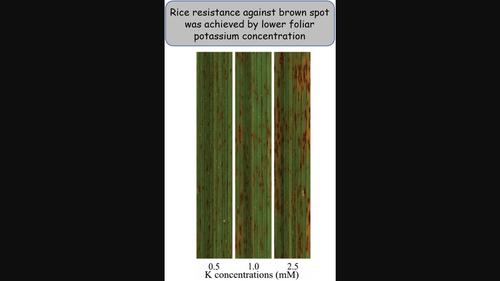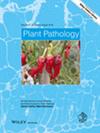水稻抗稻瘟病是由低叶面钾浓度介导的
IF 2.4
3区 农林科学
Q1 AGRONOMY
引用次数: 0
摘要
水稻褐斑病是水稻的一种重要病害。研究了钾对水稻抗褐斑病的影响。工作假设是,较高的叶面钾浓度可以使植物对真菌感染作出更有效的反应。植株生长在三种钾浓度(0.5、1.0和2.5 mM)的营养液中,分别接种或未接种米芽孢杆菌。测定了植物的光合性能、防御酶和抗氧化酶的活性以及活性氧、酚类物质和木质素的浓度。与0.5 mM K处理相比,1.0和2.5 mM K处理的植株叶片钾浓度分别显著提高38%和91%,其中1.0和2.5 mM K处理的褐斑严重程度(≥20%)显著高于0.5 mM K处理(≤15%)。在2.5 mM K条件下,植物的褐斑严重程度较高,导致光合机构发生变化,叶绿素a + b和类胡萝卜素浓度降低,过氧化氢和超氧阴离子自由基的产生增加。相比之下,0.5 mM K处理下植株防御酶和抗氧化酶活性的提高和酚类物质的增加有助于它们更有效地应对米芽孢杆菌的感染。综上所述,水稻抗褐斑病是通过保持较低的叶面钾浓度、更积极的防御反应、强大的抗氧化系统和更少的光合器官损伤来实现的。本文章由计算机程序翻译,如有差异,请以英文原文为准。

Rice resistance against Bipolaris oryzae infection is mediated by lower foliar potassium concentration
Brown spot, caused by Bipolaris oryzae, is a very important disease of rice. This study investigated the effect of potassium (K) on rice resistance to brown spot. The working hypothesis tested was that higher foliar K concentration could allow plants to respond more efficiently against fungal infection. Plants were grown in nutrient solution amended with three K rates (0.5, 1.0 and 2.5 mM) and noninoculated or inoculated with B. oryzae. The photosynthetic performance of plants, activities of defence and antioxidant enzymes and the concentrations of reactive oxygen species, phenolics and lignin were determined. Foliar K concentration was significantly higher by 38% and 91% for plants supplied with 1.0 and 2.5 mM K, respectively, compared to plants supplied with 0.5 mM K. Brown spot severity was significantly higher (≥20%) for plants supplied with 1.0 and 2.5 mM K than those supplied with 0.5 mM K (≤15%). Higher brown spot severity for plants supplied with 2.5 mM K resulted in changes in the photosynthetic apparatus, reduced chlorophyll a + b and carotenoids concentrations, and higher production of hydrogen peroxide and superoxide anion radical. In contrast, higher activities of defence and antioxidant enzymes and more production of phenolics for plants supplied with 0.5 mM K helped them to cope with B. oryzae infection more efficiently. In conclusion, rice resistance against brown spot was achieved by keeping a lower foliar K concentration linked to more active defence reactions, a robust antioxidative system and less damage to the photosynthetic apparatus.
求助全文
通过发布文献求助,成功后即可免费获取论文全文。
去求助
来源期刊

Plant Pathology
生物-农艺学
CiteScore
5.60
自引率
7.40%
发文量
147
审稿时长
3 months
期刊介绍:
This international journal, owned and edited by the British Society for Plant Pathology, covers all aspects of plant pathology and reaches subscribers in 80 countries. Top quality original research papers and critical reviews from around the world cover: diseases of temperate and tropical plants caused by fungi, bacteria, viruses, phytoplasmas and nematodes; physiological, biochemical, molecular, ecological, genetic and economic aspects of plant pathology; disease epidemiology and modelling; disease appraisal and crop loss assessment; and plant disease control and disease-related crop management.
 求助内容:
求助内容: 应助结果提醒方式:
应助结果提醒方式:


